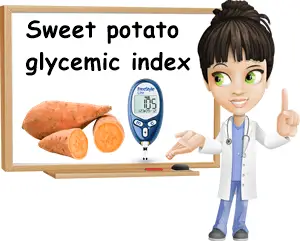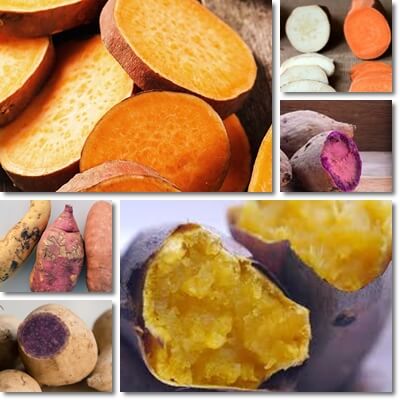In short, eating sweet potatoes doesn’t lower blood sugar levels in diabetes type 1 or 2 or in non-diabetics. On the contrary, sweet potatoes raise blood sugar levels. Despite their good fiber content, they are a significant source of carbohydrates, about 20 g per 100 g of tubers. And carbohydrates naturally raise blood sugar levels. Not to mention that various cooking methods concentrate the sugars by reducing moisture content in the potato, add to the existing sugar or make the carbohydrates easier to digest by altering their structure which further contributes towards such effects.
While felicitous food associations may lower the glycemic index of the sweet potato and somewhat reduce effects on blood sugar metabolism, some the same associations may encourage weight gain or lead to high blood pressure over time, both complications for diabetics. For example, it’s recommended that high carbohydrate foods be paired with sources of animal protein such as eggs, cheese or meat, which have such a low glycemic index that they cannot even be considered to have an effect on blood sugar.

The protein (and fat) in animal foods has a hypoglycemic action and lowers the effects of high glycemic foods such as sweet potatoes, rendering them more suitable for diabetic diets, in limited amounts of course. But eating potatoes along with sources of protein and fat too often and in too large amounts can, over time, lead to weight gain which is a source of complications for diabetes, despite the protein and fat limiting the effects on blood sugar of the potatoes.
What is the glycemic index?
The glycemic index (GI) is a scale that measures how the carbohydrates in a food raise blood sugar levels. Below 55 is a low GI. Between 55-69 is a moderate GI. Between 70-100 is a high GI. Diabetics are advised to choose foods as low as possible on the GI scale to best manage their blood sugar levels.
What is the glycemic index of sweet potatoes?
Sweet potato glycemic index is an estimated of 70, which puts the sweet tuberous vegetable high on the glycemic index scale. Because of this, it’s not recommended in a diabetic diet, except for small amounts occasionally. Eating sweet potato too frequently, even in small amounts, or in large amounts at once will raise blood sugar levels which is bad for diabetes both short and long-term.

Cooking changes the glycemic index and impacts blood sugar effects
Just as important, choice of cooking method and cooking time influence glycemic index values. There are reports that show the glycemic index of sweet potatoes fluctuating from low (below 55) to moderate to high (over 90). This can be explained by the varying carbohydrate and sugar content in different sweet potato varieties. Also, a longer baking time weakens the structure of carbohydrates in the tuber, allowing for a faster digestion and a similarly faster absorption of nutrients, including sugar. Baking generates higher GI values than boiling, but boiling time is best kept short to minimize effects on blood sugar.
Moreover, eating sweet potatoes separate from other foods or in combination with high-carbohydrate, high-sugar foods (such as with marshmallows or chocolate in baked goods) ups their glycemic index and makes them wholly unsuitable for consumption by diabetics. Because the glycemic index fluctuates greatly based on choice of cooking method, cooking time, variety of potato and choice of accompanying foods, diabetics looking to include the vegetable in their diet are better off looking at serving size and carbohydrate content to best anticipate the effects on blood sugar levels.
So can a diabetic eat sweet potato?
It’s okay for diabetics to eat sweet potatoes, but they can only eat small amounts safely, preferably not every day. Ideally, all diabetics should plan their meals ahead whenever they want to include foods such as this into their diet and rely on counting carbohydrates if they want to prevent spikes in blood sugar levels. Considering how much sugar a sweet potato has (up to 10 g of sugar/100 g of cooked tuber), it’s advisable to avoid pairing the tuber with other high-carbohydrate foods and instead opt for animal protein, whether eggs, a small piece of cheese or some lean meat.
How to eat sweet potatoes if you have diabetes
If you’ve ever wondered how to cook and eat sweet potatoes for diabetes so they don’t raise blood sugar levels, then here is some useful information about how different cooking methods, food associations and other factors influence their nutrition and health effects:
1) Sweet potato fries are low glycemic. This is because the oil or fat used for frying takes longer to digest and thus slows down the entire digestion, including that of the carbohydrates in the potatoes, resulting in a lower than usual glycemic index. The disadvantage is that regular consumption promotes weight gain due to the higher fat content. If salt is used, then there is also the issue of high blood pressure, a rather common concern among diabetics.
2) Longer the cooking time, higher glycemic values. A raw potato is definitely hard to eat and even harder to digest. This is the main reason why we cook most foods – to make them more easily digestible. But the longer you cook a plant food, the more it softens, to the point said food becomes almost pre-digested. The more a plant food softens, the less chewing it requires and the more easily it is digested and the nutrients it provides, including carbohydrates, absorbed. This also means a higher glycemic index and a faster rise in blood sugar levels. It’s also why baked sweet potatoes have a higher GI than sweet potatoes boiled for, let’s say, 15 minutes (baking takes longer).
3) Baked and roasted vs boiled sweet potatoes. In addition to cooking time, choice of cooking method also influences how sweet potatoes affect blood sugar levels. Experiments show that baking and roasting generates a higher glycemic load than boiling. For example, baked sweet potatoes have a GI over 90-94. Roasted ones have a GI of 79-84 and up to 93 or more. Boiling may generate a GI as low as 41-44.
The explanation for this is that boiling causes the starches amylose and amylopectin to bind with water and gelatinize which reduces glycemic index and allows for a steadier, more controlled rise in blood sugar. Whereas baking and roasting presuppose dry heat and extract the moisture out of the tuber, concentrating carbs and sugars. The initial carbohydrate content of the tuber also matters since different varieties have different carbohydrate values.
4) Cooking sweet potatoes in smaller pieces is better than cooking them whole. Although not by very much. In addition to a faster cooking time, it helps get rid of some of the starch which will ooze out in the cooking water, slightly reducing carbohydrate content.
5) Counting carbs and monitoring intake are still the best solutions if you have diabetes (considering the fluctuating glycemic index values). Eat small servings, no more than one serving a day and preferably not everyday. Count the carbohydrates in a serving and adjust the rest of your meal to accommodate for the high-carbohydrate choice. If it helps, consider it your main high-carb food and fill the rest of your plate with low-carb green vegetables and animal protein (eggs, lean meat, a bit of cheese).
6) Let cool. Prepare your potatoes in advance and eat them the next day, cold. It has been observed that starch reorganizes itself as it cools down from cooking, resulting in a resistant form that takes longer to digest. This also means a lower-glycemic food.
7) Pair them wisely. All diabetics know that it’s better to eat carbs with protein and a little fat. If you want to eat sweet potatoes but not have them cause high blood sugar levels, pair them with some lean animal protein (chicken, fish, a bit of low-fat cheese or eggs). But still keep intake low, tailored to your individual nutritional requirements.
Definitely avoid sweet potato pie, especially if it’s with marshmallows or chocolate or anything sweet. A soup might be okay if it’s eaten in limited amounts and has leafy greens and some lean protein. Mashed sweet potatoes are better avoided since anything pureed is also readily digestible and high-glycemic, especially ready to eat, from flakes in a box.
White or sweet potatoes for diabetes?
What is better for a diabetic to eat: sweet potato or white potato? Both, but in limited amounts, as part of an overall balanced and varied diet, tailored to the individual nutritional requirements of the diabetic person and the restrictions of their condition. Remember that both white and sweet potatoes eaten by themselves are relatively high glycemic. Baking and roasting generate the highest glycemic values and raise blood sugar levels the most. Boiling is better for diabetes with sometimes low glycemic values. It also depends on the variety which determines starch, sugar and fiber content and subsequent effects.
However, if we were to consider overall nutrition density, sweet potatoes rank higher and are better for diabetics because they provide more nutrients with benefits for the condition. From magnesium and potassium for high blood pressure, B vitamins for diabetes-associated skin and nerve damage, the vitamin A precursor beta-carotene for better eyesight (in orange varieties) to antioxidant and anti-inflammatory effects, they may be a better choice of a potato even though they don’t lower blood sugar levels.
